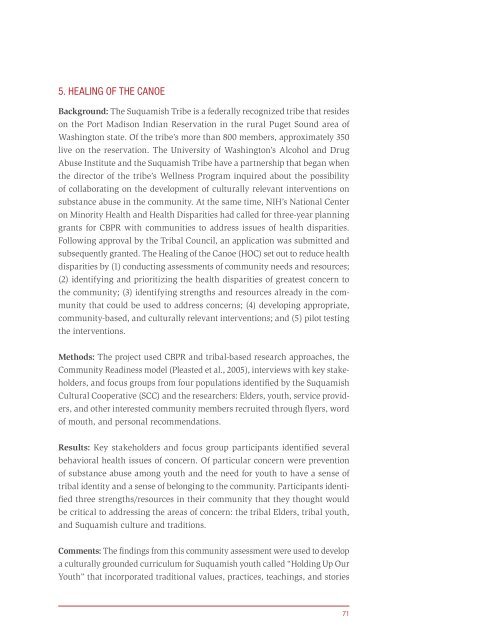Principles of Community Engagement (Second Edition)
Principles of Community Engagement (Second Edition)
Principles of Community Engagement (Second Edition)
You also want an ePaper? Increase the reach of your titles
YUMPU automatically turns print PDFs into web optimized ePapers that Google loves.
5. HEALING OF THE CANOE<br />
Background: The Suquamish Tribe is a federally recognized tribe that resides<br />
on the Port Madison Indian Reservation in the rural Puget Sound area <strong>of</strong><br />
Washington state Of the tribe’s more than 800 members, approximately 350<br />
live on the reservation The University <strong>of</strong> Washington’s Alcohol and Drug<br />
Abuse Institute and the Suquamish Tribe have a partnership that began when<br />
the director <strong>of</strong> the tribe’s Wellness Program inquired about the possibility<br />
<strong>of</strong> collaborating on the development <strong>of</strong> culturally relevant interventions on<br />
substance abuse in the community At the same time, NIH’s National Center<br />
on Minority Health and Health Disparities had called for three-year planning<br />
grants for CBPR with communities to address issues <strong>of</strong> health disparities<br />
Following approval by the Tribal Council, an application was submitted and<br />
subsequently granted The Healing <strong>of</strong> the Canoe (HOC) set out to reduce health<br />
disparities by (1) conducting assessments <strong>of</strong> community needs and resources;<br />
(2) identifying and prioritizing the health disparities <strong>of</strong> greatest concern to<br />
the community; (3) identifying strengths and resources already in the community<br />
that could be used to address concerns; (4) developing appropriate,<br />
community-based, and culturally relevant interventions; and (5) pilot testing<br />
the interventions<br />
Methods: The project used CBPR and tribal-based research approaches, the<br />
<strong>Community</strong> Readiness model (Pleasted et al , 2005), interviews with key stakeholders,<br />
and focus groups from four populations identified by the Suquamish<br />
Cultural Cooperative (SCC) and the researchers: Elders, youth, service providers,<br />
and other interested community members recruited through flyers, word<br />
<strong>of</strong> mouth, and personal recommendations<br />
Results: Key stakeholders and focus group participants identified several<br />
behavioral health issues <strong>of</strong> concern Of particular concern were prevention<br />
<strong>of</strong> substance abuse among youth and the need for youth to have a sense <strong>of</strong><br />
tribal identity and a sense <strong>of</strong> belonging to the community Participants identified<br />
three strengths/resources in their community that they thought would<br />
be critical to addressing the areas <strong>of</strong> concern: the tribal Elders, tribal youth,<br />
and Suquamish culture and traditions<br />
Comments: The findings from this community assessment were used to develop<br />
a culturally grounded curriculum for Suquamish youth called “Holding Up Our<br />
Youth” that incorporated traditional values, practices, teachings, and stories<br />
71

















